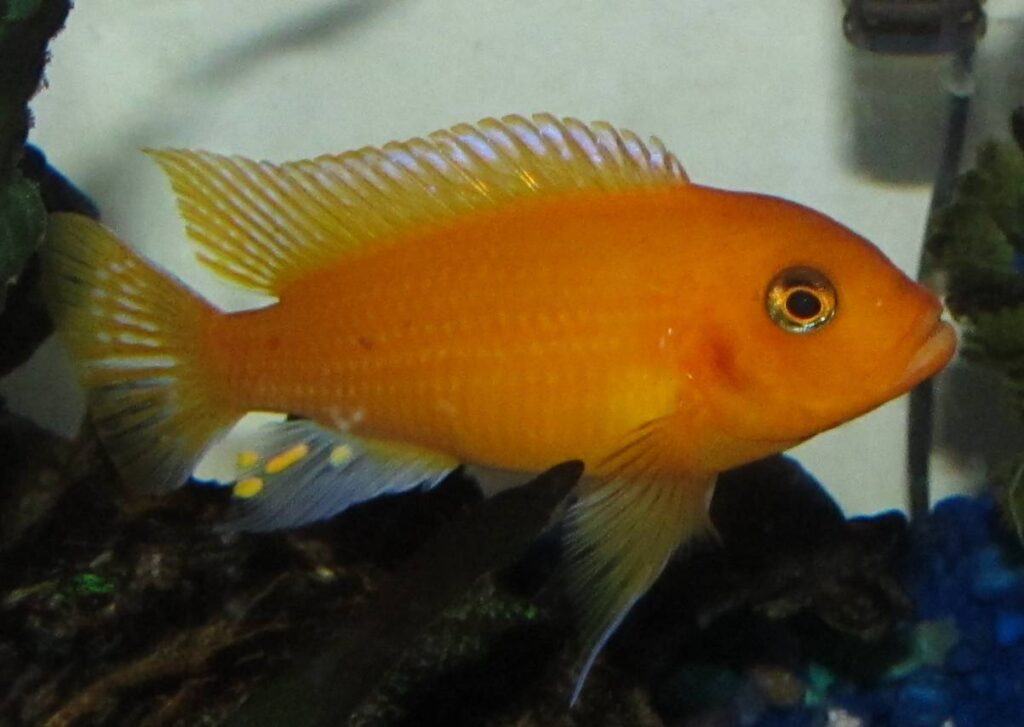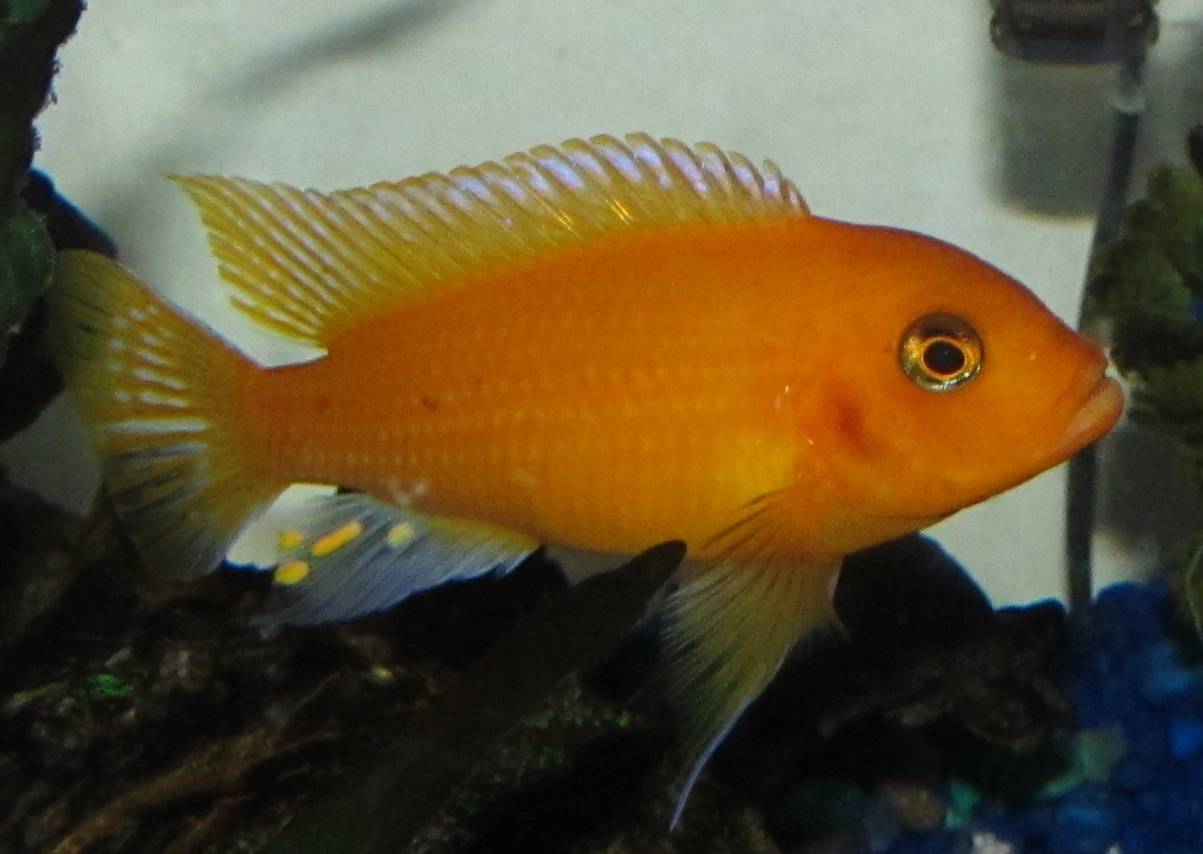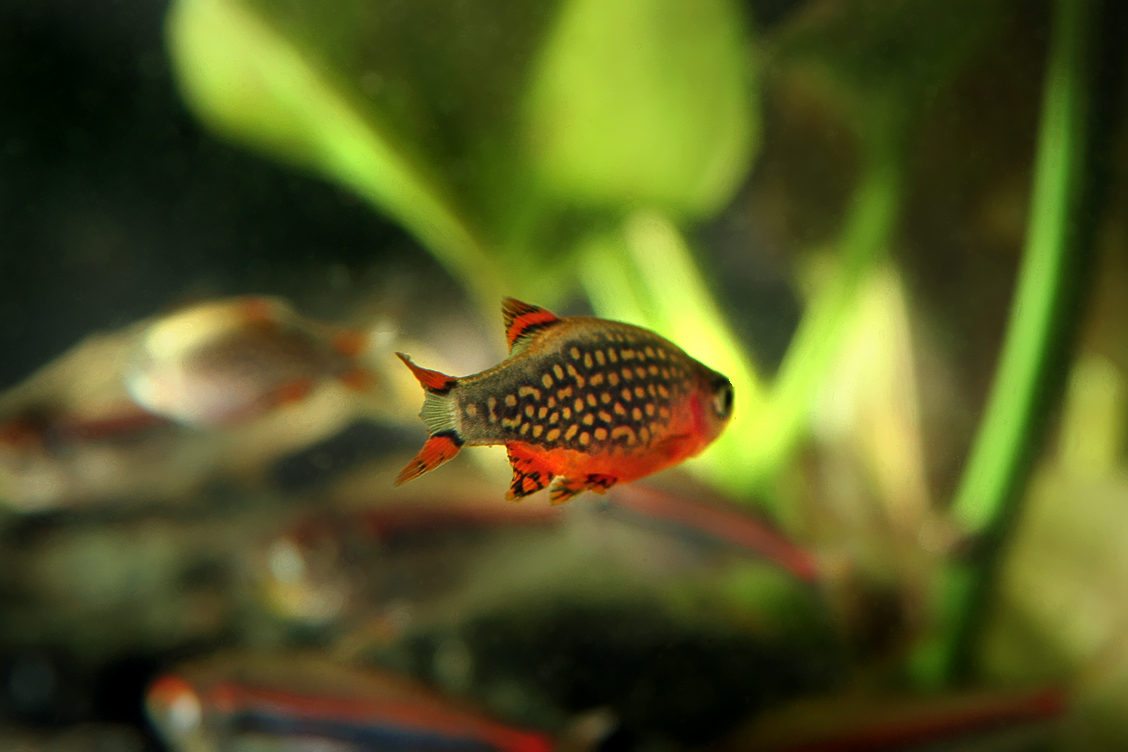Dive into the heart of Lake Malawi with the captivating Red Zebra Cichlid (Maylandia estherae). This species has a rich history tied to the crystal clear waters of this African lake. Named in honor of Esther Grant, the wife of a cichlid exporter, the Red Zebra Cichlid has become a cherished species among aquarium enthusiasts. Its tale from the wild waters of Lake Malawi to the serene aquariums globally is as colorful as its vibrant scales.
Now, let’s immerse ourselves in the scientific realms of the Red Zebra Cichlid. Belonging to the genus Maylandia, the species name estherae encapsulates a part of its historical roots. Its journey through the scientific classifications starts at the domain Eukaryota, moving through the kingdom Animalia, phylum Chordata, class Actinopterygii, order Cichliformes, to finally rest at the family Cichlidae. Each classification not only denotes its evolutionary lineage but also its close relations to other cichlid fish, a vast family known for its diversity and unique behaviors.
The Red Zebra Cichlid is a spectacle of colors. Despite its name, this species showcases a range of colors from beige to bright blue. The most popular variants among enthusiasts are the Cherry Red and Ice Blue Red Top Zebra Cichlids, whose deep red and bright blue hues respectively, are a sight to behold in any aquarium setting. But color is not the only intriguing aspect; their polymorphic nature allows for a variety of appearances even within the same species.
The natural habitat of our focal species is as unique as its color palette. Nestled in the rocky crevices of Lake Malawi, these cichlids prefer warm, slow-moving waters. Their preference for rocky substrates gives them ample hiding spots, hinting at a behavior inclined towards territoriality. While not strictly bottom-dwellers, their rock-dwelling behavior often finds them in the mid to lower sections of the water column.
A peek into their dietary preferences reveals a primarily herbivorous diet, with algae being a staple. Their bold personalities shine through in their territorial behavior, especially among males. This territoriality is a trait shared among many in the cichlid family, making a spacious tank a necessity for keeping the peace.
Now, let’s delve into some statistics. The males, growing up to 12.7 cm, are slightly larger than the females, who reach up to 10 cm in size. Their life expectancy ranges between 10 to 15 years, a testament to their hardy nature amidst the sometimes turbulent waters of their native habitat.
On a lighter note, some fun facts about the Red Zebra Cichlid include an albino variant, a unique appearance within the species. Their striking color patterns are not just a visual delight but also a topic of interest among aquarists. And did we mention they are mouthbrooders? The females carry the fertilized eggs and fry in their mouths for about 21 days, an intriguing aspect of their reproductive behavior.
The Red Zebra Cichlid is not considered rare but is highly sought after by collectors and aquarium enthusiasts, thanks to its bright colors and bold personality. Each variant, each color morph, and each behavior displayed is a page from the natural history of Lake Malawi, making the Red Zebra Cichlid a living testament to the aquatic biodiversity of East Africa.
This comprehensive insight into the Red Zebra Cichlid (Maylandia estherae) not only enriches our understanding but also guides aspiring aquarists on a journey of successful fish keeping. With the right care, ideal tank mates, and a glimpse into their natural history, you are well on your way to creating a harmonious aquatic haven for these colorful cichlids.

Key Information
The Red Zebra Cichlid (Maylandia estherae), a charismatic resident of the rocky shores of Lake Malawi, is a spectacle of nature’s palette. This cichlid species is not just famed for its bright hues but also for the variety of color variants it presents. From the deep reds of the Cherry Red Zebra to the cool blues of the Ice Blue Red Top Zebra, each variant is a testament to the remarkable biodiversity nestled in the heart of East Africa. The fascinating journey of understanding and caring for the Red Zebra Cichlid begins with a peek into its many variants, each carrying a unique blend of nature’s brilliance and a legacy of Lake Malawi’s aquatic life.
| Family | Cichlidae |
| Price | Ranges based on variant, typically $7 – $20 |
| Common Names | Red Zebra Cichlid |
| Variants | Cherry Red Zebra, Ice Blue Red Top Zebra |
| Ideal Tank Size | Minimum 30 gallons |
| Water Parameters | pH 7.8-8.6, Temperature 75-80°F, Hardness 10-20 dGH |
| Lifespan | 10 – 15 years |
| Full Size | Males up to 5 inches, Females up to 4 inches |
| Natural Environment | Lake Malawi, East Africa |
| Behavior | Territorial, especially among males |
| Habitat Preference | Rocky substrates with ample hiding spots |
| Aquarium Decoration | Rocks, caves, and robust plants |
| Ideal Tank Mates | Other Mbuna cichlids, avoid overly aggressive fish |
| Fish to Avoid | Larger predatory fish, overly aggressive cichlids |
| Best Foods/Diet | Primarily herbivorous, algae-based foods |
| Disease | Susceptible to typical freshwater fish diseases like Ich |
| Sex-Switch | Uncommon |
| Gender Differences | Males are generally larger and more brightly colored |
| Care Level | Moderate, requires consistent water quality |
| Breeding Level | Moderate, mouthbrooding species |
Ideal Tank Mates
The Red Zebra Cichlid (Maylandia estherae) is a lively and territorial species native to the rocky shores of Lake Malawi in East Africa. When considering tank mates for the Red Zebra Cichlid, it’s crucial to select species that can coexist harmoniously in a similar environment. Ideal tank mates should be able to withstand the Red Zebra Cichlid’s territorial tendencies and thrive in similar water conditions. It’s also beneficial if the tank mates have a different appearance or coloration to avoid aggression triggered by mistaken identity. Here are 15 ideal tank mates for the Red Zebra Cichlid, along with explanations of why they are compatible:
Yellow Lab Cichlid (Labidochromis caeruleus)
The Yellow Lab Cichlid is a peaceful Mbuna cichlid that can coexist well with Red Zebra Cichlids. They are both from Lake Malawi and share similar water condition requirements. Their distinctly different coloration helps minimize territorial disputes.
Acei Cichlid (Pseudotropheus Acei)
Acei Cichlids are known for their peaceful temperament and can coexist well with Red Zebra Cichlids. They share similar dietary and environmental requirements which makes them compatible tank mates.
Rusty Cichlid (Iodotropheus sprengerae)
The Rusty Cichlid is another peaceful species from Lake Malawi. They have a distinct coloration and a mild temperament that can help in reducing aggression in the tank.
Cobalt Blue Zebra Cichlid (Maylandia callainos)
Sharing similar environmental needs with the Red Zebra Cichlid, the Cobalt Blue Zebra Cichlid can coexist harmoniously given adequate space to establish territories.
Maingano Cichlid (Melanochromis cyaneorhabdos)
With their striking blue-black stripes, Maingano Cichlids are not only a visually appealing addition, but their temperament aligns well with the Red Zebra Cichlids, making them a compatible choice.
Kenyi Cichlid (Maylandia lombardoi)
Kenyi Cichlids are from Lake Malawi as well and can adapt to similar water conditions as the Red Zebra Cichlid. Their different coloration and pattern help in reducing aggression.
White-Tailed Acei (Pseudotropheus Acei “Ngara”)
This variant of Acei Cichlid, with its peaceful nature and distinct white-tailed feature, can coexist well with the Red Zebra Cichlid, sharing similar environmental preferences.
Snow White Cichlid (Pseudotropheus socolofi “Albino”)
The Snow White Cichlid’s calm demeanor and contrasting coloration make it a good tank mate for Red Zebra Cichlids, allowing for a colorful and peaceful coexistence.
Demasoni Cichlid (Pseudotropheus demasoni)
Demasoni Cichlids, with their stunning blue and black stripes, can be a compatible tank mate as they share similar Lake Malawi origins and water condition preferences with Red Zebra Cichlids.
Johanni Cichlid (Melanochromis johannii)
Their vibrant blue and black stripes set them apart visually from Red Zebra Cichlids, helping to minimize territorial disputes, while their similar environmental needs ensure harmonious coexistence.
Afra Cichlid (Cynotilapia afra)
Afra Cichlids are small, peaceful cichlids from Lake Malawi with a temperament that can match well with the Red Zebra Cichlids, given proper space for territory.
Electric Yellow Cichlid (Labidochromis caeruleus)
Their bright yellow coloration creates a stunning contrast with Red Zebra Cichlids, while their peaceful nature and similar environmental needs make them compatible tank mates.
Bumblebee Cichlid (Pseudotropheus crabro)
Bumblebee Cichlids are robust and can hold their own with territorial species like the Red Zebra Cichlid, making them a suitable choice for a mixed cichlid aquarium.
Auratus Cichlid (Melanochromis auratus)
With distinct coloration and a compatible temperament when provided with enough space, Auratus Cichlids can be a harmonious addition to a Red Zebra Cichlid tank.
Elongatus Cichlid (Pseudotropheus elongatus)
Elongatus Cichlids have a distinct appearance and a temperament that can mesh well with Red Zebra Cichlids, given adequate space and environmental conditions conducive to reducing stress and aggression.
The harmonious coexistence of Red Zebra Cichlids with these ideal tank mates can lead to a vibrant, lively, and interactive aquatic environment. Each species, with its unique colors and behaviors, contributes to creating a microcosm of Lake Malawi’s rich biodiversity within the confines of an aquarium.
FAQs
Can Red Zebra Cichlids live with plants?
Yes, Red Zebra Cichlids can live with plants in the aquarium. However, it’s crucial to choose robust and sturdy plants like Anubias or Java Fern that can withstand the digging behavior of these cichlids.
What are the primary predators of Red Zebra Cichlids in the wild?
In their natural habitat of Lake Malawi, Red Zebra Cichlids might fall prey to larger predatory fish such as African Tigerfish or Nile Perch.
Do Red Zebra Cichlids have any specific lighting requirements in the aquarium?
Red Zebra Cichlids do not have any specific lighting requirements. Standard aquarium lighting that replicates a natural day and night cycle is suitable for them.
How do Red Zebra Cichlids communicate or interact with each other?
Red Zebra Cichlids communicate primarily through body language and color displays. Dominant or territorial individuals often exhibit brighter colors and assertive postures.
Are Red Zebra Cichlids prone to any particular diseases due to their color variants?
There isn’t evidence to suggest that different color variants of Red Zebra Cichlids are more susceptible to specific diseases. However, like other freshwater fish, they can be prone to common ailments like Ich or fin rot if water conditions are not maintained properly.
Is there a particular time of year when Red Zebra Cichlids breed more frequently?
In the wild, the breeding season of Red Zebra Cichlids might align with the warmer months. However, in a controlled aquarium setting, they can breed year-round provided the water conditions and temperature are kept stable.
How do Red Zebra Cichlids react to their reflection?
Red Zebra Cichlids might react to their reflection by displaying territorial behaviors, thinking there’s another cichlid in the tank. It’s advisable to minimize reflections to reduce stress.







